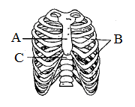EASY
Earn 100
The figure given here is of rib cage. Identify the parts labelled as and and select the correct option.


(a)
| A | B | C | |
| (a) | Coccyx | Ribs | Vertebral Column |
(b)
| A | B | C | |
| (b) | Sternum | Ribs | Vertebral Column |
(c)
| A | B | C | |
| (c) | Scapula | Ribs | Vertebral Column |
(d)
| A | B | C | |
| (d) | Tarsal | Ribs | Vertebral Column |
100% studentsanswered this correctly
Important Questions on Locomotion and Movement
EASY
MEDIUM
MEDIUM
Match the following.
| SET-I | SET-II | ||
| (A) | Os penis | (I) | Sesamoid bone |
| (B) | Girdle | (II) | Visceral bone |
| (C) | Patella | (III) | Cartilage bone |
| (D) | Cranium | (IV) | Investing bone |
EASY
EASY
MEDIUM
EASY
HARD
EASY
EASY
MEDIUM
EASY
HARD
MEDIUM
MEDIUM
EASY
EASY
HARD
MEDIUM
Match the following columns and select the correct option.
| Column-I | Column-II | ||
| (a) | Floating Ribs | (i) | Located between second and seventh ribs |
| (b) | Acromion | (ii) | Head of the Humerus |
| (c) | Scapula | (iii) | Clavicle |
| (d) | Glenoid cavity | (iv) | Do not connect with the sternum |
EASY

